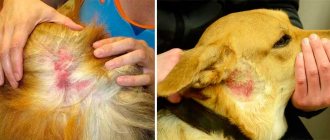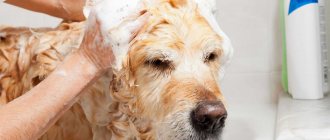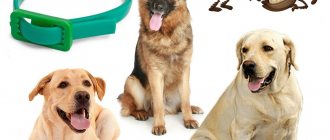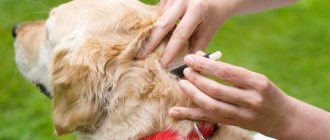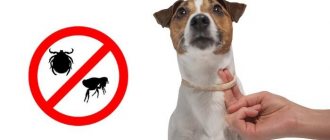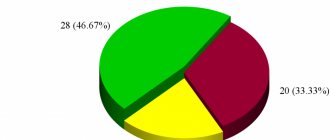A dog tick collar is one of the most used means of protecting pets. What should you consider when choosing? What is the principle of their operation? Let's consider a comparative analysis of the TOP 5 best.
The following types of tick protection for dogs are currently used:
- Drops on the withers against ticks;
- Anti-tick sprays and aerosols;
- Flea and tick tablets;
- Collars, leashes, keychains against ticks and fleas;
- Vaccinations.
If previously it was enough to use only one means of protection, now several are needed, combining drugs of different groups and compositions. One of them is a tick collar for dogs.
How to choose a safe and effective anti-tick collar for dogs, what are the features of its use, advantages and disadvantages? Read in this material.
Why do dogs need flea protection?
Fleas, ticks and other parasites pose a real threat to the health of the dog, as well as its owner. They cause discomfort and can cause infection with dangerous diseases. Substances released by parasites when they bite can cause an allergic reaction. Long-term flea parasitism leads to hair loss, disturbs the pet and deprives it of normal sleep. When bitten by fleas, dogs scratch the affected areas, introducing infection into the scratches. In addition, fleas are carriers of helminths, which parasitize the dog’s intestines and release toxic substances. Fortunately, there are many insect repellent products available today. One of them is a flea and tick dog collar.
Purpose and risk factors
Anti-tick collars for dogs are used to prevent acarosis caused by bites from almost 20 species of ticks, and entomosis caused by fleas.
The use of dog collars reduces the risk of babesiosis, Lyme disease, borreliosis, ehrlichiosis and anaplasmosis due to ectoparasite bites.
The danger of a dog being bitten by ticks and other ectoparasites
About the varieties of ticks, habitats and features of their development in a separate material on the site.
How does a flea collar work?
The collar is a strap or ribbon made of a flexible but durable material with a microporous structure. During the production process, the tape is impregnated with active substances, the required piece is cut off, supplemented with a fixative and hermetically packaged. The tightness of the packaging is a very important requirement. The collar starts working the minute you open the package. The product is attached to the dog’s neck, but the active substances it releases are gradually distributed throughout the body. Thanks to the micropores in the polymer tape, this process is quite lengthy. By selecting various materials it can be extended over several months.
The ingredients contained in the collar are designed to destroy and/or repel blood-sucking parasites, and/or disrupt the development of larvae. The active substances can be different, depending on them the effect of the collar is determined (insecticidal, acaricidal, ovicidal or repellent).
Please note that you should not expect instant results. A high degree of protection is achieved within a few days. During this time, the active substances are released from the collar and penetrate into the fatty secretion of the coat and the sebaceous glands of the skin. If the collar has expired, it must be replaced with a new one, otherwise it loses its meaning.
Types of flea collars
In fact, collars can act not only on fleas, but also on lice, lice, ticks and other external parasites. All existing flea collars for dogs can be divided into 3 large categories: destructive, repellent, ultrasonic.
Insectoacaricidal (destroying)
These collars are most effective because their action is aimed at destroying parasites. The active substances kill adults and may interfere with the growth of larvae. The validity period of the product depends on its type and is usually 2–7 months. To maintain effectiveness, the collar should not be removed from your pet, except when the animal needs to be washed. Sometimes, before the first use, it is necessary to stretch the collar a little to activate the substances (the need for this action should be indicated in the instructions).
Repellent (scaring)
Their task is to repel fleas and other blood-sucking insects. The main active substances are usually essential oils and extracts. They have a higher safety profile, but their effectiveness is lower than that of insecticides. As a rule, biocollars are used in conjunction with other, more effective means.
Most collars are universal: they are suitable for both adult dogs and puppies. Some manufacturers are developing products for children and for dogs of small and large breeds. Generally, flea collars of any type are not recommended for puppies under 2 months of age.
Ultrasonic
Theoretically, they produce high-frequency sounds that repel arthropods. The effectiveness of such devices has not been confirmed.
How to figure out who is affected by a flea collar
Typically, the range of parasites that the collar is effective against is indicated on the packaging. It’s a little more difficult to understand the special terminology, but it’s also possible.
“Cidal” action implies the destruction of the parasite. Acaricides destroy ticks, insecticides destroy insects. Insectoacaricides – both. Inhibitors of chitin synthesis have ovo- and larvocidal effects. These are substances that disrupt the process of molting and oviposition in insects. Ovo is an egg, and larva is a larva. Such substances are relevant if the animal is infected with fleas, lice or lice, because eggs are more difficult to destroy than adults. Repellents are substances whose odor repels arthropods. They can be either natural (essential oils) or synthetic (“DEET”, etc.). Multi-component collars often contain insectoacaricides, ovicides, and repellents.
Pros and cons of safety collars
If you follow the instructions and recommendations of a specialist, a flea collar for a dog will become a reliable barrier against blood-sucking insects and ticks. This tool has a number of advantages:
- Ease of use;
- variety of choice (to determine the appropriate collar in each case);
- high safety profile (the collar is securely fixed to reduce the risk of it being removed, biting, or licking chemicals);
- duration of action;
- reasonable price.
Often, a collar looks like a more convenient means than drops and sprays, however, it also has its drawbacks:
- the product requires getting used to, the dog may be against another strap around the neck;
- insecticides and repellents may cause allergic reactions;
- the smell of essential oils may seem too intense;
- Since the substances are concentrated in the plastic tape and not on the skin, they take time to become active. So collars are not the best choice for instantly getting rid of fleas.
Owner reviews
Andrey B. Collar “Barrier”:
I would like to write a review about the Barrier collar, which I purchased on the advice of a veterinarian. I took it for my yard dog, who was tormented by a horde of fleas. In the package I found a black, specific-smelling half-meter tape with a reliable fastener of the simplest design. The fastening is so-so, but the dog did not get rid of the collar. By the way, the smell quickly dissipated. And a week later all the fleas disappeared; Kuzya and I didn’t think about them for another year.
Inga T. Collar “Beaphar”:
My daughter persuaded my husband and I to buy a Jack Russell Terrier puppy. We took a five-month-old miracle and walked with him in a park overgrown with bushes for fear of ticks. It turned out that drops should not be used for babies and we took the risk of buying a Beaphar collar. Of course, the manufacturer writes that this is a puppy collar for older children, but we were very afraid of catching a tick. We wore it for 4 months, and the little one didn’t bring a single tick or flea home.
Maria S. Biocollar “DoctorZoo”
I bought two DoctorZoo biocollars for my dogs. As soon as I opened the package I felt a sharp, unpleasant smell (reminiscent of Indian mosquito repellent tablets). The smell did not disappear from the house for a long time, and the clasp turned out to be very fragile, it was easily unfastened by a small child. For some reason, the fleas were not afraid, but on the contrary, there were more of them, they spread throughout all the rooms. The collars had to be removed, the dogs developed allergies, they scratched all over their sides, smearing blood on the floors and carpets.
Alexey K. Review of the Foresto collar
Unfortunately, I had some negative experiences using this model for an active German Shepherd. The young dog broke the fastening during the game, the owners tried to repair it themselves, but it didn’t help. The strip was not tightly attached to the neck and a re-infestation of fleas occurred. I had to undergo a course of treatment and buy a new one.
Rules of application
Despite their popularity and high degree of safety, dog collars are used strictly according to the instructions. It must be remembered that improper use of the product can cause a lot of inconvenience to the animal.
- The collar is fixed on the dog in such a way that there is a gap of 1–1.5 cm (an average finger thickness) between it and the neck. The strap should not dangle or fit too tightly.
- Each dog has its own type of collar. This takes into account her weight, neck size, and health indicators. Collars are not recommended for small puppies for safety reasons.
- The collar must be replaced with a new one immediately after its service life expires. Typically, such products do not last more than 4-6 months, but the specific period is always indicated in the instructions.
- You cannot use a collar and apply other anti-flea products on the same day, as this can lead to poisoning of the animal.
- It is best to buy a flea collar for your dog at a large pet store or veterinary pharmacy, so you can be sure of its quality.
Why are fleas and ticks dangerous?
Fleas don’t just pester pets, causing them to simply tear their skin, they carry pathogens of dangerous diseases and cause allergies. Just because a dog doesn't go outside doesn't mean he'll never see fleas.
These small parasites can get into the house on clothes and shoes; all you have to do is walk through the entrance where an infected animal has been. If your dog goes out for a walk, it’s easy to pick up parasites. For example, by talking to a stray dog or playing with a neighbor’s infected pet.
Until recently, a tick was waiting for a walking dog in the forest or in a forest plantation. But climate change has led to an increase in the population of dangerous blood-sucking creatures, so you can even find parasites on bushes growing near your home. Danger awaits pets walking in parks, on the banks of a river, or even while relaxing at sea.
The last decade has added another problem for dog breeders, which can be solved with the help of a collar. Dogs are bitten by breeding mosquitoes that carry heartworms. Growing helminths move under the skin, can live in mucous membranes or affect internal organs (leading to death).
Precautionary measures
- Most collars (especially the insecticidal and insectoacaricidal groups) are contraindicated for pregnant and lactating females, sick and weakened dogs, and puppies. Collars with phytocomponents have fewer contraindications, but can cause an allergic reaction.
- During the first hours of wearing the collar, the dog should be under constant supervision. If your animal experiences any unpleasant symptoms (lacrimation, vomiting, fever, skin irritation, etc.), you should immediately remove the collar and consult a specialist.
- Do not store a flea collar (especially an opened package) near food, personal belongings, or in places accessible to children and animals.
- It is important to ensure that your four-legged pet does not try the collar on its teeth, as its active substances can cause disorders of the digestive and nervous systems.
Recommended Collars
BARS®.
The insecticidal collar is used to protect against fleas, ixodid ticks, lice, and lice. The polymer tape can be 80 cm long (for large dogs), 50 cm (for medium dogs) and 35 cm (for small dogs). The collar contains fipronil and diflubenzuron. The insect growth regulator (diflubenzuron) suppresses the growth of integumentary tissues of parasites, disrupts the development of larvae in eggs and molting, and prevents pupae from fully developing. Fipronil is an insectoacaricide. It is not absorbed into the systemic circulation. Its accumulation occurs in the epidermis, hair follicles and sebaceous glands. With the secretion of the sebaceous glands, the substances are distributed over the surface of the skin and provide a long-lasting protective effect. The period of use of the BARS® collar is up to 4 months. It is not recommended to use the collar for puppies under 2 months of age, sick and weakened animals, pregnant (in the last third of the term) and lactating females.
FitoDoc®
. The repellent collar is designed to repel ixodid ticks, fleas, and other insects. It comes in 3 sizes: 80 cm (for large breed dogs), 50 cm (for medium dogs) and 35 cm (for small dogs). The collar contains natural ingredients: essential oils of margosa, citronella, eucalyptus, tea tree, lavender. They also accumulate on the epidermis, hair follicles and sebaceous glands of the animal's body and provide a repellent effect. The FitoDoc® collar provides protection for 3 months against fleas and other insects and up to 5 weeks against ticks. The product should not be used on puppies under 2 months of age.
4 with a ponytail®
. This collar is designed to repel fleas, lice, lice, scabies and ixodid mites. It contains essential oils of citronella, lavender, geranium, peppermint, eucalyptus. Active substances accumulate in the sebaceous glands and have a detrimental effect on insects. The collars are available in three sizes: 35, 50 and 65 cm. The product has a high safety profile and is usually well tolerated by dogs of different ages and breeds, including sick and weakened animals, pregnant and lactating females. It should not be used only for puppies younger than 2 months and with individual intolerance to the active substances. When worn continuously, the collar provides protection against insects for up to 3 months and against ticks for 4 weeks.
Varieties
A dog anti-tick collar is a flexible tape impregnated with a special compound. Most often these are insecticidal agents that repel and kill ticks after a bite. The collar begins to work after heating from the animal’s body: the active substance is distributed throughout the dog’s fur and skin. It will take about two days to completely protect your pet. You can’t even shoot at night to prevent the effect from weakening.
If the composition has saturated the fur, it will act during washing and temperature changes. The collar works stably throughout the entire period of wear. After the dog removes the protective tape, the substance will lose the required concentration and will not be able to repel parasites. Anti-tick collars come in three types.
Chemical
Leading in popularity and availability. Their price is usually low. The collar is impregnated with an insecticidal solution. It is an effective remedy against fleas and ticks, but has a harmful composition and a short service life.
Biological
Essential oils and natural herbs are used as impregnation for the tape. Such collars are more expensive and work in a gentle mode. This is the best option for puppies, pregnant and lactating dogs. They are also recommended for animals in the process of recovering from an illness.
Ultrasonic
They look like a small pendant-like device. The device emits high-frequency vibrations that repel parasites. The effectiveness of these collars is questionable. Some owners note changes in their dogs' behavior: they become lethargic and apathetic. The human ear is unable to hear high-frequency sounds. Dogs pick up an ultrasonic signal that can cause depression. Such collars cost an order of magnitude more.
